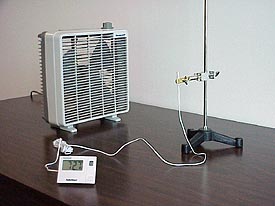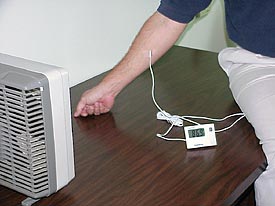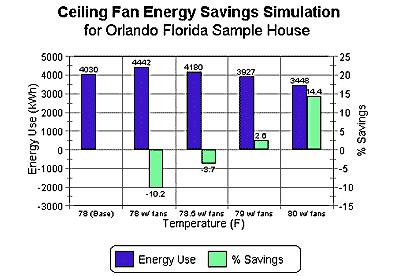

Background
These activities are designed to demonstrate convective heat transfer while also looking at some common convection experiences. There is a common misconception, for example, that a ceiling fan will cool air in the room that it’s in. This activity will show that non-wetted surfaces will not be cooled by moving air if the surface and air are the same temperature, but that convection can cool the surface of objects (or people) that are warmer than the air.
Materials
- Lab stand (1 total)
- Clamps and clamp holders (as needed to hold thermometer)
- Thermometer or electronic temperature sensor with displays (1 total)
- Small box or circular fan (1 total)
Part 1- Do fans cool the air?
|
 Figure 1: Example of Convection Activity 1 setup. |
|
|
Data Analysis and Discussion
- Plot and average the data.
- Ask the
questions:
- What happened when the fan was turned on?
- What happened when it was turned off again?
- What can we conclude?
- Why?
- Even if your results didn’t clearly show this, include in discussion that fans will actually slightly heat the air in a room because of the heat given off by the motor.
Convection
Activity 1 Sample Results |
||
Fan
Status |
Time
(min) |
Tair
(oF) |
Off
|
0 |
73.2 |
On |
1 |
73.2 |
On |
2 |
73.2 |
On |
3 |
73.2 |
On |
4 |
73.4 |
On |
5 |
73.4 |
Off |
6 |
73.4 |
Off |
7 |
73.6 |
Off |
8 |
73.4 |
Off |
9 |
73.2 |
Off |
10 |
73.4 |
Part 2- Do fans cool people?
|
 Figure 2: Example of Convection Activity 2 setup. |
|
|
Data Analysis and Discussion
[From the last experiment some students may have gotten the idea that the student will not be cooled by the fan.]
- Plot the
data.
- What happened when the fan was turned on?
- What happened when it was turned off again?
- What can we conclude?
- Why?
- Note that the convection is causing two effects:
- Since the surface of the skin is warmer than the air the fan is blowing on it, it is being cooled.
- Cooling
that is actually produced by moisture on the skin is evaporating.
- If you
live in a colder climate or it’s winter, also discuss wind chill,
which is the same cooling effect of moving air on exposed skin, but
is caused by wind and is generally an undesired cooling effect!
- So based
on what we’ve learned, how can we improve how we use ceiling fans?
- We know that ceiling fans only do us any good if there is someone in the room to benefit from the air movement.
- Research has shown that because of the cooling we saw in the Part 2 experiment above, effective use of ceiling fans can allow thermostat setpoints to be raised 2-3oF and occupants be just as comfortable as they were at a lower temperature without the fans.
- Figure 3 shows simulation results indicating increased home cooling energy use though from ceiling fans (because of motor uses electricity and produces heat) unless the thermostat setpoint is increased.
- The key to achieving energy savings from ceiling fans is to also raise setpoints when fans are in use.
- Using ceiling fans properly can also save energy on days when turning on a fan will allow a family not to turn on the air conditioner at all when they would have chosen to if the fans were not available.
 |
||
| Figure 3: Simulation plot shows that cooling energy use is increased when ceiling fans are used unless thermostat setpoint is also raised. |
National Science Standards | Glossary | References | Site Map | Feedback Form
Individual pages from this web site may be printed
and duplicated for
student classroom use
provided that proper credit is given to
the Florida Solar
Energy Center (FSEC).
